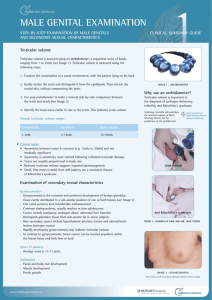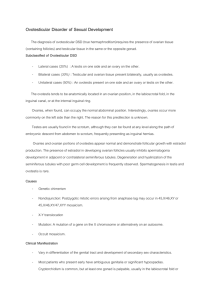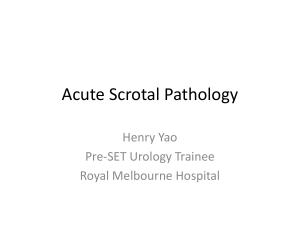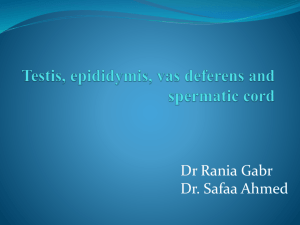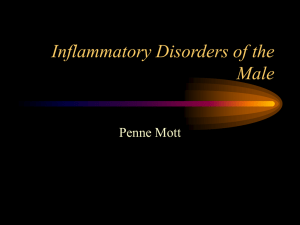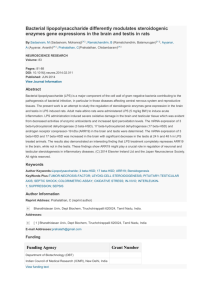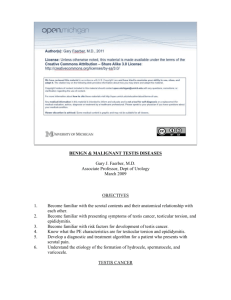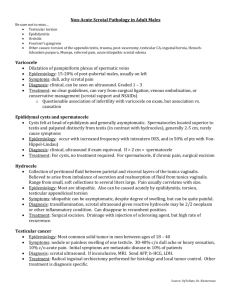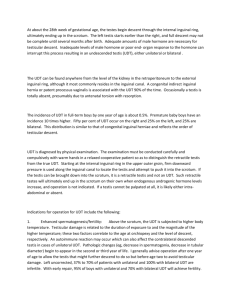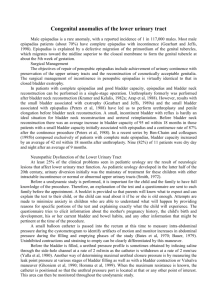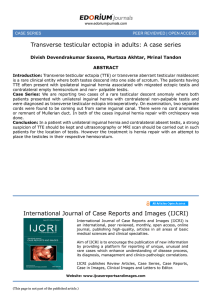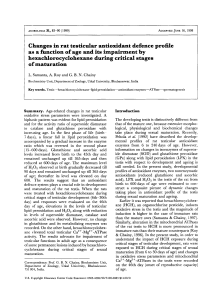Embryology of the Testis Parks and Jameson Endocrinology 146(3):1035–1042
advertisement
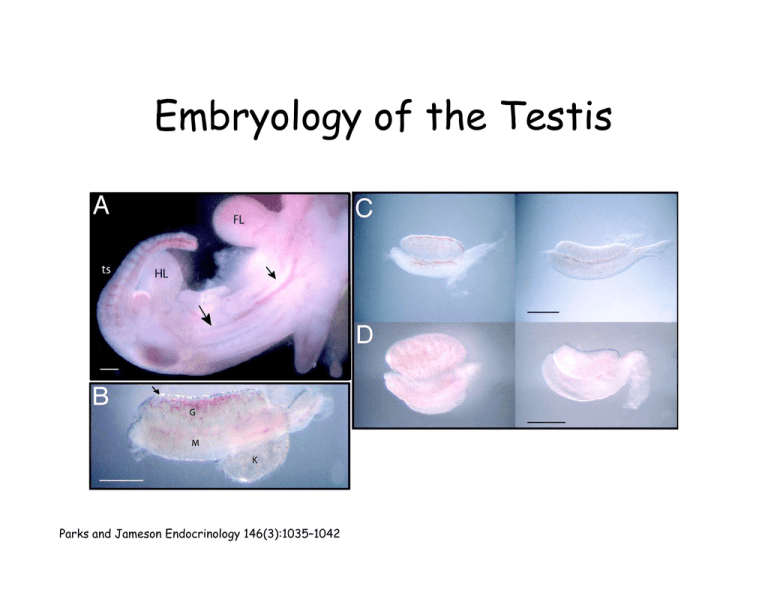
Embryology of the Testis Parks and Jameson Endocrinology 146(3):1035–1042 Human Testicular Development T. Klonisch et al. Developmental Biology 270 (2004) 1–18 8 week human Medulla: inner part Cortex: outermost layer 7 week human 16-20 week human 20-24 week human Cell Lineages in Testis & Ovary Soder (2007) Best Practice & Research Clinical Endocrinology & Metabolism 21: 381–391. Timing of Major Testicular Events in Mammals • Variation among mammals in timing • Process similar T. Klonisch et al. Developmental Biology 270 (2004) 1–18 Genes - Ovary/Testis Development Parks and Jameson Endocrinology 146(3):1035–1042 Scrotum • in most adult mammals testis lies in the scrotum – migrates there through the body wall - inguinal canal – some exceptions: • testis is lumbar - monotremes, elephants, hyraxes • inguinal canal - hedgehogs, moles, some seals • seasonal migration - wild ungulates, most rodents Cryptorchidism • cryptorchidism - "hidden" "abdominal" testis – Undescended testis in those species with scrotal testis – detrimental to spermatogenesis and normal testicular metabolism – associated with increased risk of testicular cancer – rise in US & Europe in last 30-40 years Descent of the Mammalian Testis T. Klonisch et al. Developmental Biology 270 (2004) 1–18 Model for testicular migration • 1) migration of testis apparently involves two phases – Initial stage is transabdominal migration – Second stage is passage through the inguinal canal • 2) A number of hormones are involved in this process – INSL3 (insulin-like peptide hormone 3) – Testosterone Model for testicular migration • testis is firmly attached to abdominal wall by: – a) posterior gonadal ligament – b) gubernaculum (Latin: helm or rudder) • as body grows gubernaculum does not grow extensively; thus, testis is drawn downward Intra-abdominal testicular descent to the inner inguinal ring • • • • • Human: initiated at about 10–14 weeks of gestation to about weeks 20–23 insulin-like peptide hormone INSL3 – structurally closely related to relaxin – marker of mature testicular Leydig cells – G protein-coupled receptor LGR8 Mouse: Bilateral cryptorchidism in INSL3-/- mice – small, undifferentiated gubernacula without a central core of mesenchyme Transgenic INSL3-/- male mice – Overexpressing INSL3 in pancreatic beta-cells – Normal transabdominal testis descent Transgenic female mice overexpressing INSL3 – displayed descended ovaries and inguinal hernia • INSL3 expression in the ovary initiated day 6 after birth testicular descent through the inguinal canal • • • • • Human: completed by week 35 in the human Pig: around day 95 of gestation in the pig fetus inguinoscrotal,but not transabdominal, testis descent is impaired – LH receptor knockout mouse (LuRKO) • devoid of LH stimulation – hypogonadal (hpg) mouse • lacking the gonadotropins FSH and LH mutated GnRH gene Gubernaculum and the cranial suspensory ligament (CSL) – sexually dimorphic structures – target tissues of androgens Regression of the CSL is an androgen-dependent process – androgens are unable to suppress CSL formation in • male bats with retractable testes • testicond mammals lacking testis descent – (Paenungulata,Monotremata, Edentata, Cetacea) Testicular descent through the inguinal canal • • • • • • Gubernaculum sexually dimorphic structure – target tissue of androgens levels of AR is initially expressed independently of androgens – both sexes Then – increase in ligand-dependent manner in the male – female gubernaculum expression of AR declines Balance between AR and estrogen receptors (ERα and ERβ) important factor – Treatment of neonatal rats with DES suppresses both T levels and AR expression Inhibition of androgen signaling – by the anti-androgen flutamide – significant increase in ERα and ERβ Masculinization of the Genitofemoral nerve • Testosterone: masculinizing effects on the sensory nucleus of the genitofemoral nerve (GFN) • In males, – L1 to L2 of the dorsal root ganglia – Unilateral transsection of the GFN causes ipsilateral cryptorchidism • Sensory branch of the GFN acts via the neurotransmitter – calcitonin gene-related peptide (CGRP) – affects gubernacular migration during the inguinoscrotal phase. • CGRP elicits rhythmic contractions of gubernacula – stimulates growth and differentiation of neonatal myogenic cells Comparative Testis Development T. Klonisch et al. Developmental Biology 270 (2004) 1–18 Genes - Cryptorchidism T. Klonisch et al. Developmental Biology 270 (2004) 1–18 Summary - Ovary & Testis Soder (2007) Best Practice & Research Clinical Endocrinology & Metabolism 21: 381–391.
